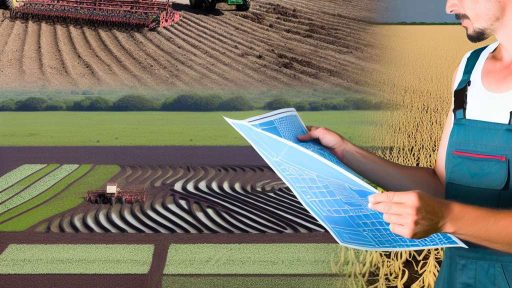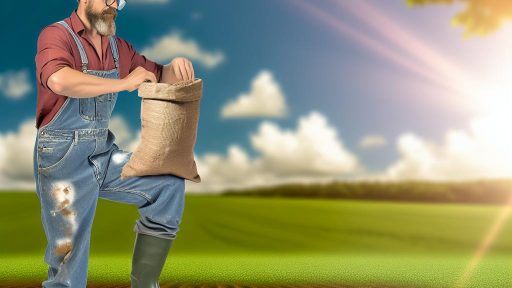Introduction to Water Conservation in Agriculture
Water conservation is essential for sustainable agriculture.
Farming requires substantial water resources, making efficient use crucial.
Climate change intensifies the need for effective water management strategies.
Farmers increasingly face water scarcity and fluctuating rainfall.
Implementing water conservation techniques benefits crop yields significantly.
Understanding the Importance of Water Conservation
Water conservation helps optimize resource use on farms.
Efficient practices reduce operational costs for farmers.
Additionally, these methods enhance soil health and productivity.
Farmers can also protect local water supplies through conservation efforts.
Current Challenges in Agricultural Water Use
Over-extraction of water leads to aquifer depletion.
Contaminated water sources pose risks to crop quality.
Furthermore, inefficient irrigation practices waste water resources.
Weather variability complicates consistent water availability for farms.
Technologies Supporting Water Conservation
Modern irrigation technologies improve water efficiency.
Drip irrigation systems deliver water directly to plant roots.
Transform Your Agribusiness
Unlock your farm's potential with expert advice tailored to your needs. Get actionable steps that drive real results.
Get StartedSoil moisture sensors help farmers monitor field conditions.
Automated irrigation systems optimize water usage based on data.
Adopting Sustainable Practices
Crop rotation can improve soil moisture retention.
Cover cropping adds organic matter and conserves moisture in the soil.
Minimizing tillage reduces soil erosion and improves water infiltration.
Additionally, creating contour farms can manage runoff effectively.
Community and Government Initiatives
Local governments can provide resources for farmers aimed at conservation.
Educational programs raise awareness about efficient water use practices.
Community support networks foster knowledge sharing among farmers.
Furthermore, incentive programs encourage the adoption of water-saving technologies.
Importance of Water Conservation for Sustainable Farming
Understanding the Role of Water
Water is essential for all forms of life, including crops and livestock.
Farmers rely heavily on water for irrigation and other agricultural processes.
Efficient water use can significantly enhance farm productivity.
Challenges Faced by Farmers
Farmers encounter water scarcity due to climate change and over-extraction.
These challenges lead to reduced crop yields and increased costs.
Consequently, investing in water conservation becomes vital for sustainability.
Benefits of Water Conservation
Implementing water conservation techniques increases farm resilience.
It helps maintain consistent crop production, even during droughts.
Moreover, conserving water enhances soil health and biodiversity.
This approach leads to lower operational costs for farmers in the long run.
Promoting Sustainable Practices
Farmers should adopt sustainable practices to use water wisely.
Training programs can educate them on effective water management techniques.
Local communities can collaborate to implement larger conservation projects.
Ultimately, fostering a culture of sustainability benefits everyone.
Showcase Your Farming Business
Publish your professional farming services profile on our blog for a one-time fee of $200 and reach a dedicated audience of farmers and agribusiness owners.
Publish Your ProfileRainwater Harvesting Techniques for Farms
Introduction to Rainwater Harvesting
Rainwater harvesting collects and stores rainwater for later use.
This technique supports agricultural sustainability and reduces groundwater reliance.
Farmers can implement simple and cost-effective systems to enhance their water supply.
Benefits of Rainwater Harvesting
There are numerous advantages to harvesting rainwater for farms.
First, it saves costs on water bills and reduces dependency on municipal supply.
Second, using rainwater can improve crop yield through better irrigation strategies.
Moreover, rainwater is often of higher quality than groundwater due to fewer contaminants.
Collection Systems
Farmers can choose from various rainwater collection systems.
- Rooftop collection systems channel water from building roofs.
- Surface run-off collection captures water from landscapes and fields.
- Swales and basins can store excess water during heavy rainfall.
Storage Solutions
Choosing the right storage solution is essential for effective rainwater harvesting.
- Rain barrels are suitable for small-scale operations.
- Underground tanks maximize space and protect water quality.
- Above-ground tanks are easy to install and maintain.
Filtration and Treatment
Proper filtration and treatment ensure harvested rainwater is safe for use.
Simple mesh filters can remove debris before water enters storage tanks.
Advanced systems may include UV treatment to eliminate pathogens.
Irrigation Methods
Implementing efficient irrigation methods is crucial for maximizing rainwater use.
- Drip irrigation delivers water directly to plant roots, minimizing waste.
- Sprinkler systems cover larger areas and can be managed based on rainfall.
- Gravity-fed systems reduce energy costs and can be highly effective.
Maintenance Practices
Regular maintenance keeps the rainwater harvesting system functioning efficiently.
Farmers should inspect collection surfaces for debris accumulation.
Additionally, they must ensure that storage tanks are sealed and clean.
Routine checks on filters and treatment systems extend the lifespan of the setup.
Community Involvement and Education
Engaging the community can enhance the effectiveness of rainwater harvesting practices.
Farmers can share knowledge through workshops and forums.
Collaboration with local organizations supports wider adoption of these systems.
Explore Further: Enhancing Soil Health with Diversified Farming Practices
Implementing Drip Irrigation Systems
Overview of Drip Irrigation
Drip irrigation delivers water directly to plant roots.
This system minimizes evaporation and runoff.
Due to its efficiency, farmers save both water and money.
Key Components of Drip Irrigation
Drip irrigation consists of various key components.
First, there are the main water supply lines.
Additionally, emitters control water flow to each plant.
Filters remove debris from the water source.
Finally, pressure regulators maintain consistent water pressure.
Benefits of Using Drip Irrigation
Drip irrigation offers numerous advantages for farmers.
It significantly reduces water usage compared to traditional methods.
Moreover, it encourages deeper root growth in plants.
This system allows precise water application based on plant needs.
Consequently, farmers observe improved crop quality and yields.
Considerations for Implementing Drip Irrigation
Farmers should consider several factors before implementation.
First, they must assess the availability of water resources.
Next, understanding soil types helps in system design.
It is crucial to choose appropriate materials for tubing and emitters.
Lastly, ongoing maintenance is essential for system efficiency.
Case Studies of Successful Drip Irrigation
Successful implementations showcase the effectiveness of drip irrigation.
Showcase Your Farming Business
Publish your professional farming services profile on our blog for a one-time fee of $200 and reach a dedicated audience of farmers and agribusiness owners.
Publish Your ProfileThe Thompson Family Farm in California increased yield by 30%.
Using this system, they reduced water consumption by 50%.
Another success story is Green Valley Orchards in Texas.
They improved overall crop health significantly using drip irrigation.
Getting Started with Drip Irrigation
Starting a drip irrigation project requires careful planning.
First, select the fields that will benefit the most.
Next, determine the water requirements for each crop.
Then, design a layout that maximizes efficiency.
Finally, install the system and monitor its performance regularly.
Explore Further: Diversifying Farm Operations with Aquaculture Integration
Soil Moisture Management and Maintenance Practices
Understanding Soil Moisture
Soil moisture significantly influences agricultural productivity.
It affects plant growth, nutrient uptake, and crop yields.
Moreover, efficient use of soil moisture contributes to sustainability.
Effective Water Conservation Techniques
Farmers can implement various water conservation practices.
One effective method is using mulch to retain moisture.
Additionally, cover crops improve soil structure and moisture retention.
Moreover, adopting contour farming minimizes runoff and soil erosion.
Utilizing Technology for Monitoring
Technology plays a crucial role in soil moisture management.
Soil moisture sensors offer real-time data on moisture levels.
Farmers can make informed irrigation decisions based on this data.
Furthermore, satellite imagery aids in assessing soil health effectively.
Implementing Irrigation Systems
Efficient irrigation systems are vital for conserving water usage.
Drip irrigation delivers water directly to plant roots.
This method reduces wastage and enhances soil moisture levels.
Sprinkler systems offer flexibility for different crop types.
Regular Maintenance and Assessment
Regular soil assessments help in maintaining optimal moisture levels.
Farmers should test soil pH and nutrient content periodically.
Additionally, adjusting practices based on soil health is essential.
These assessments foster a better understanding of moisture retention.
Community and Knowledge Sharing
Collaboration within farming communities can enhance practices.
Farmers can learn from each other’s experiences and successful methods.
Workshops and seminars provide valuable information on new techniques.
Ultimately, sharing knowledge leads to improved water conservation strategies.
See Related Content: Building a Strong Brand in the Agribusiness Sector

Use of Mulching to Reduce Evaporation
Understanding Mulching
Mulching involves covering the soil surface with organic or inorganic materials.
This technique retains moisture and protects soil structure.
Moreover, mulching suppresses weed growth effectively.
Types of Mulch
Various materials are suitable for mulching.
Straw is a popular organic option for its moisture-retaining properties.
Wood chips provide aesthetic appeal and practical benefits.
Showcase Your Farming Business
Publish your professional farming services profile on our blog for a one-time fee of $200 and reach a dedicated audience of farmers and agribusiness owners.
Publish Your ProfilePlastic sheeting is an effective inorganic choice for weed control.
Benefits of Mulching
Mulching significantly reduces evaporation from the soil.
It maintains optimal moisture levels for crops.
Additionally, it moderates soil temperature fluctuations.
Healthy soil promotes stronger plant growth and higher yields.
Applying Mulch Effectively
To apply mulch, prepare the soil properly first.
Next, spread a layer of mulch around plants and crops evenly.
A thickness of two to four inches is typically recommended.
Finally, monitor the mulch layer regularly for effectiveness.
Challenges and Considerations
Mulching may attract certain pests if not managed carefully.
Excessive moisture can lead to fungal issues in organic mulch.
Choosing the right type of mulch is crucial for success.
Furthermore, consider local climate and plant needs when mulching.
Discover More: Sustainable Crop Rotation Strategies for Long-Term Farming Success
Crop Selection and Rotation for Improved Water Use Efficiency
Understanding Water-Smart Crops
Selecting the right crops is essential for efficient water usage.
Consider drought-resistant varieties for areas with limited rainfall.
These crops can survive longer without water and require less irrigation.
Furthermore, assess local climate conditions when making selections.
This approach ensures crops thrive in their environment, maximizing yield.
Benefits of Crop Rotation
Crop rotation enhances soil health and conserves water.
By alternating crops, farmers can improve nutrient availability in the soil.
This practice reduces pest populations and soil erosion over time.
In addition, it helps maintain moisture levels in the ground.
As a result, farmers experience more reliable harvests.
Implementing Effective Rotational Strategies
Begin by mapping out your current crop patterns.
Introduce legumes into the rotation to fix nitrogen in the soil.
Include deep-rooted plants that can access water from deeper layers.
Additionally, use cover crops during off-seasons to retain moisture.
These practices will collectively lead to better water conservation.
Monitoring and Adjusting Crop Choices
Regularly evaluate the effectiveness of your crop selections.
Track water usage and yield results to inform future decisions.
If certain crops underperform, consider switching to more appropriate varieties.
Adaptability is crucial in responding to changing environmental factors.
Stay updated with agricultural research to identify evolving practices.
Adoption of Water-Saving Technologies and Equipment
Importance of Water-Saving Techniques
Water scarcity is an ongoing challenge for farmers.
Implementing water-saving technologies can enhance sustainability.
These techniques reduce water waste effectively.
Moreover, they contribute to cost savings over time.
Types of Water-Saving Technologies
Various technologies exist to promote water conservation.
Drip irrigation systems provide precise water application.
Showcase Your Farming Business
Publish your professional farming services profile on our blog for a one-time fee of $200 and reach a dedicated audience of farmers and agribusiness owners.
Publish Your ProfileThese systems target root zones directly.
In addition, they minimize evaporation and runoff.
Rainwater harvesting systems capture and store precipitation.
This method enhances water availability during dry seasons.
Farmers can use stored water for irrigation needs.
Use of Soil Moisture Sensors
Soil moisture sensors accurately monitor conditions.
They allow farmers to irrigate based on actual need.
Consequently, this practice conserves significant water resources.
Efficient Irrigation Scheduling
Employing efficient irrigation scheduling maximizes water use.
Farmers can adjust schedules based on seasonal weather patterns.
This approach ensures optimal crop hydration.
Integration of Technology Solutions
Smart farming solutions integrate various technologies.
These systems provide real-time data and analytics.
Farmers can make informed decisions for irrigation management.
Case Studies of Successful Implementation
Numerous farms have successfully adopted these techniques.
For example, Meadow Farms implemented drip irrigation.
As a result, they reduced their water usage by 40%.
Another notable case is Green Acres, which uses rainwater harvesting.
This practice has significantly improved their water efficiency.
Future Innovations in Water Conservation
The future holds promising innovations in water conservation.
Research is ongoing in developing drought-resistant crops.
Technologies like cloud-based irrigation management are emerging.
Such innovations will further enhance sustainable farming practices.




